Climate
change: how China moved from leader to laggard
Beijing’s
U-turn on renewables is triggering alarm ahead of UN meeting
FT,
24 November, 2019
The
smoggy city of Baoding is known for two things: donkey burgers, and
solar panels. An industrial centre just south of Beijing — 45
minutes via high-speed rail — the city’s high-tech zone styles
itself as “Power Valley” because it is home to so many solar
manufacturers.
But
for Vincent Yu, deputy general manager at Yingli Solar, one of the
first renewables companies to set up in the city, business has been
difficult lately. “These last two years, there has been a lot of
pressure. The subsidies for solar projects have fallen,” Mr Yu
says. New solar installations in China — running at 53 gigawatts in
2017 when demand peaked — will be about 40 per cent lower this
year, he estimates.
The
photographs in his office show Yingli in its glory days a decade ago.
Sales were surging and the company spent millions sponsoring the 2010
and 2014 football World Cup tournaments. Yingli was the world’s
largest solar-panel maker in 2012 and 2013, exporting all over the
globe and celebrated in China as a national champion. Its huge
factory campus in Baoding still nods to that status, with a spacious
museum dedicated to the company’s history as a solar pioneer.
Today
Yingli is insolvent. It has been defaulting on debt payments since
2016, and in 2018 it was kicked off the New York Stock Exchange
because its market capitalisation had sunk below the minimum $50m
threshold. Although Yingli still makes solar panels, its factories
operate at a loss and the most valuable asset it has left is the land
underneath them. Some question how Yingli is still operating. But
analysts believe the political connections of its founder may have
helped stave off creditors.
The
company is the highest profile casualty of a change in policy that is
being felt across the renewable energy sector in a country once
celebrated as the world’s clean energy champion. Chinese investment
in clean energy is plummeting — down from $76bn during the first
half of 2017, to $29bn during the first half of this year.
For
the annual UN climate talks, starting next Monday, that is alarming.
Concerns
over the impact of climate change have never been higher. But the gap
between what countries should be doing, and what they are actually
doing — pumping rising levels of carbon dioxide into the air —
has never been greater. With the US withdrawing from the Paris
climate accord, an increasing amount of attention is on China.
The
country is both the greenest in the world, but also the most
polluting. It has more wind and solar power than anybody else, yet it
is also the world’s biggest builder of new coal plants. Last year,
its emissions hit a record high, accounting for more than half of the
global increase in energy-related CO2 emissions in 2018, according to
the International Energy Agency. This year, Chinese emissions are
expected to grow about 3 per cent from 2018.
“Everything
is at stake for the planet, because the Chinese economy is so much
bigger than any other,” says Adair Turner, chair of the Energy
Transitions Commission. “Even the whole of Europe is considerably
less than Chinese emissions.”
He
points to China’s current pledge, that its CO2 emissions will peak
by 2030, and says it is nowhere near ambitious enough. “Let’s be
clear, if that was all China ever did, then we are on the path to
climate disaster,” says Lord Turner, who is lobbying for China to
consider a target of net zero emissions by 2050. “That is true of
all the [countries that have made pledges under the Paris
accord] . . . everyone has always known there would have to
be very significant improvements, to get us anywhere close to 2C.”
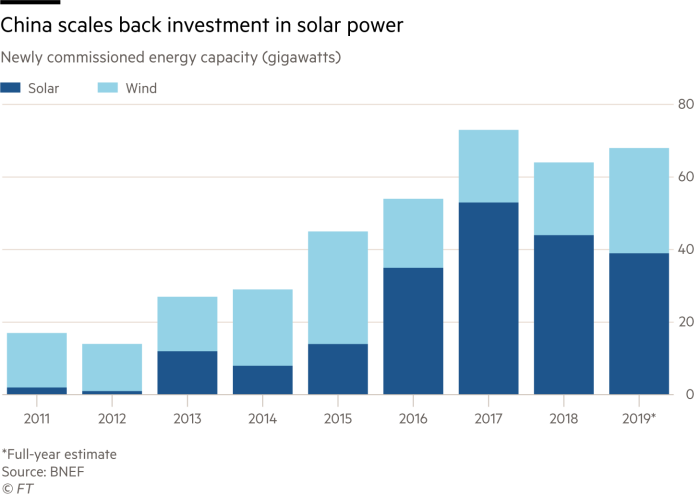
The
Paris climate accord, of which China is a signatory, pledges to limit
global warming to well below 2C. But that goal looks increasingly out
of reach. The world is on track for 3C of global warming by the end
of this century, if current trends continue. That would mean higher
sea levels of as much as 1m, threatening more than 600m people in
low-lying and coastal areas, according to a recent report from the
UN’s Intergovernmental Panel on Climate Change.
The
climate pact is under attack from many sides, and the US is
withdrawing from the agreement entirely, on President Donald Trump’s
orders. Fraying multilateralism has further eviscerated the climate
accord, which lacks any enforcement mechanism. China — distracted
by a slowing economy, the US trade war and protests in Hong Kong —
is not the only reason why the planet is on course for devastating
climate change, but it is near the top of the list.
“The
general momentum on climate and environment issues has been declining
[in China],” says Li Shuo, senior global policy adviser at
Greenpeace. Climate change has become a lower priority for Beijing.
“There is less space for the green agenda,” he says.
China’s
investment in renewable energy fell 39 per cent in the first half of
this year, compared with the same period in 2018, according to data
from Bloomberg New Energy Finance. Beijing yanked subsidies for solar
panel projects in the middle of last year, and is shrinking those for
wind, causing an abrupt shift.
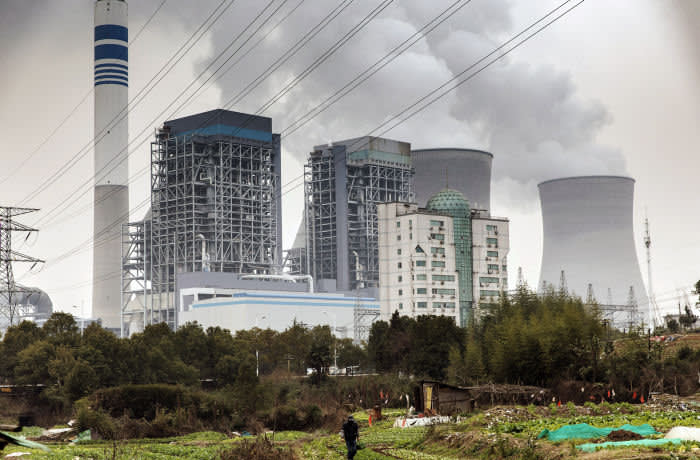
“This
is probably a low point,” says Li Junfeng, a senior renewable
energy
policymaker
and head of the National Centre for Climate Change Strategy Research,
part of the government planning ministry. “The new policy is not in
place yet, and the old policy [of subsidies] has been stopped.”
Five
years ago, when the economy was growing robustly, Beijing saw
stronger environmental policies as core to its economic
transformation away from energy-intensive heavy industry. Today, with
the economy growing at its slowest pace since the early 1990s, that
has changed.
“The
highest political priority in China is trying to stabilise the
economy,” says Kevin Tu, an energy economist who previously led the
China desk at the IEA. “Anything else, including environmental
protection, especially climate change, will have to make some room
for these political priorities.”
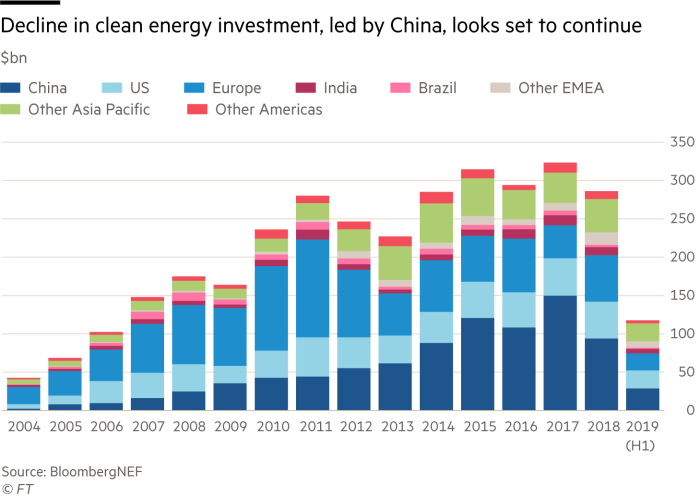
On
paper, China’s climate targets have not changed: Beijing has
pledged that its carbon dioxide emissions will peak by 2030, and that
it will draw 20 per cent of its primary energy from non-fossil
sources by that same date. Yet that promise would allow China to keep
increasing its emissions for the next decade, with devastating
implications for the planet. Its investments in the Belt and Road
Initiative, under which state banks have earmarked more than $30bn to
build coal-fired power plants in other countries, is also adding to
global emissions.
China’s
participation in the Paris climate pact in 2015 was heralded as a
great victory by activists. Convincing Beijing to set climate targets
was a top priority for the Obama administration. But baked into the
negotiations was an expectation that China would achieve its
emissions target much earlier than 2030. Next year will be crucial,
as countries that signed the Paris accord are supposed to submit
enhanced targets — but the mood in Beijing makes a tougher climate
goal less likely for China.
China
is world's biggest builder of new coal power plants © Getty
Mr
Li says deteriorating relations between the US and China — along
with the unrest in Hong Kong — have helped fuel a growing
nationalist sentiment and a broader anger at the west.
One
of the targets of this nationalist ire has been Greta Thunberg, the
Swedish teenage activist who is revered as a climate hero in some
parts of the world. “Many netizens see [Greta] as representing the
general liberal western agenda,” says Mr Li. “There is this
larger perspective that the west is ganging up against China.”
At
the same time, coal appears to be again in the ascendant with Li
Keqiang, China’s premier, last month identifying it as a priority
area. China remains the world’s biggest producer. Many see this as
part of a growing focus on energy security in Beijing, a result of
Chinese leaders being spooked by deteriorating relations with the
west. “Energy security anxiety is a blessing for the coal [sector]
in China,” says Mr Tu.
Policymakers
are also focused on keeping the cost of power cheap to help stimulate
the economy, so from January the price of electricity from coal-fired
power plants, which is centrally regulated, will be allowed to
fluctuate, and is expected to fall.
These
factors have compounded the pain for the renewable energy industry.
After benefiting from generous subsidies for more than a decade,
Beijing axed solar subsidies without warning last year. The payments
due have created a deficit of around Rmb200bn ($28bn) in the
renewable energy development fund that was paying out the subsidies.
Frank
Haugwitz, founder of Asia Europe Clean Energy (Solar) Advisory in
Hong Kong, says the subsidies contributed to a solar surge that
exceeded the government’s expectations, triggering the sudden cut.
The
dice are now loaded in coal’s favour. The new policies for
renewable energy are focused on grid parity — only building wind
and solar projects that can compete with the price of coal. Yet with
coal power prices dropping, and a glut of new coal-fired power
stations coming online, it may be challenging for wind and solar to
compete. In the wind industry, there has been a rush of projects this
year as developers try to capture the last of the subsidies.

The
diplomatic pressure on China to improve its climate targets has been
played out in public. During a state visit from Emmanuel Macron, the
French president, earlier this month, both sides issued a joint
declaration, vowing that the Paris climate deal was “irreversible”,
and promising new climate targets aimed at the middle of the century.
Chinese
policymakers such as Li Junfeng say the pressure is misplaced, as
China is likely to exceed existing climate targets, even if it does
not officially adopt new goals. “Now that the US has withdrawn from
the Paris agreement, the entire global response to climate change is
shifting,” he says. “We have to be realistic . . . There’s
no point in being in a rush.”
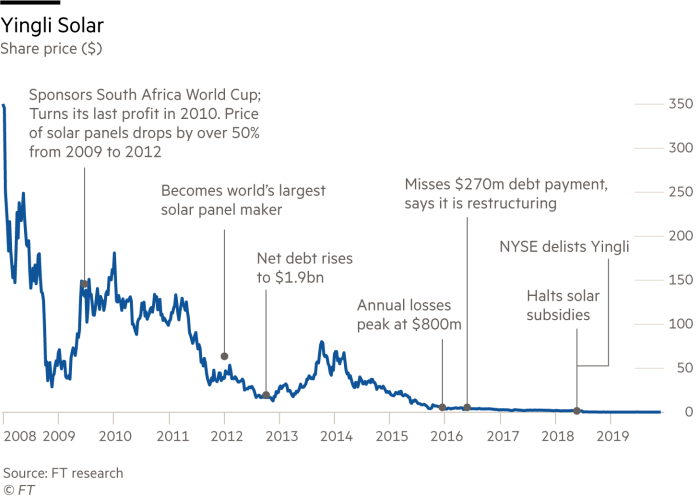
He
also points out that China has achieved, and far surpassed, most of
its previous climate targets. A pledge to cut carbon intensity —
the amount of carbon produced per unit of GDP — by between 40 and
50 per cent by 2020, compared with 2005 levels, was achieved three
years early. It also overachieved on its targets for solar
installations, although this runaway growth led to the subsidy
deficit.
For
many years, action on climate change was the one area that Beijing
and western capitals could usually agree on. Even the most hawkish
western politician would hold up China’s climate record as an
example to be praised.
But
that may be changing. “It is going to sour for sure, if China
doesn’t move in the right direction, quickly enough,” says Todd
Stern, the chief US negotiator for the Paris agreement, who adds
there is simply “less leeway” now in terms of global emissions.
“We can’t possibly do what we need to do, unless China is doing
quite a bit.”
“We
are sort of entering a new world now . . . It is not just a
sense of urgency, it is the math. Do the math, and you will see
whether we are doing enough,” says Mr Stern. “The Paris agreement
is going to rise and fall, on the level of political will in
constituent countries. That has always been true.
“The
fault is that there is a lack of political will in virtually every
country, compared to what there needs to be.”
Solar
eclipsed: a pioneering panel-maker retrenches
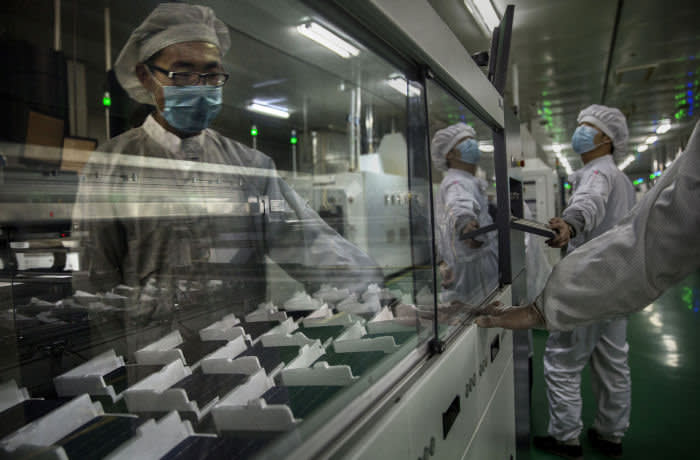
The
Yingli Solar plant in Baoding © Kevin Frayer/Getty
Stepping
on to the Yingli campus in Baoding is like stepping back in time.
Employees wear a dark navy jumpsuit with the Yingli sunburst logo on
one shoulder and a Chinese flag on the other, giving the place a
distinctly communal feel. In front of a large assembly yard, a big
stage is decorated in honour of the recent 70th anniversary of the
founding of the People’s Republic of China, plastered with slogans
such as “remember your mission” and “help each other”.
The
company’s problems began at least five years ago, as mounting debt
levels combined with plummeting panel prices. Its dire financial
situation became evident in May 2016, when Yingli failed to meet a
$270m loan payment. Discussions with debtholders, the largest of
which is China Development Bank, have since failed to reach
conclusion. Shareholders fear the worst: Yingli’s shares on the
pink sheets — the over-the-counter market for companies not listed
on a major exchange — are trading at just 15 cents a share. The cut
in government subsidies for solar projects has only compounded the
challenges.
Miao
Liansheng, the founder who started his career in the army before
becoming an entrepreneur, was once ranked among China’s richest
individuals. Mr Miao lives on the Yingli campus, and employees say
that he still makes daily appearances to chat with workers.
But
today there are fewer workers than there used to be. Many of the
factory production lines are quiet. It’s not clear if some are
under maintenance, or if they have simply been idled. The company
once had around 20,000 employees, but that has fallen to just over
6,000, according to deputy general manager Vincent Yu. This year it
will produce panels with capacity of 2.5GW-3.5GW, he says, equivalent
to about 3 per cent of global demand.
The
Yingli museum shows that the company was, in many ways, a pioneer. It
boasted the first automatic soldering equipment in China in 2005 and
the first automatic module production line in 2007. But its equipment
quickly became outdated, allowing newer entrants to undercut them.
Starting
a decade ago, China’s state support for solar panel manufacturers
led to overcapacity and vicious price wars. This pushed down the
price of solar panels — to the benefit of the rest of the world —
but meant that margins were razor-thin, or negative, for panel
manufacturers in China.

No comments:
Post a Comment
Note: only a member of this blog may post a comment.